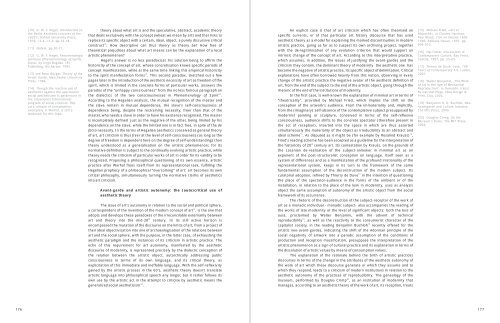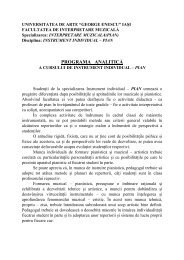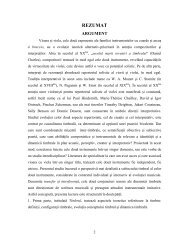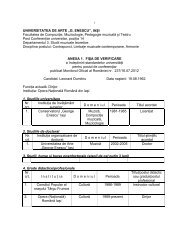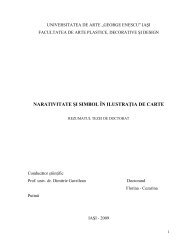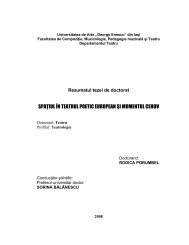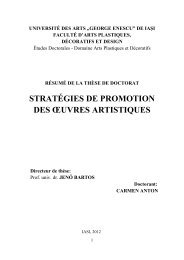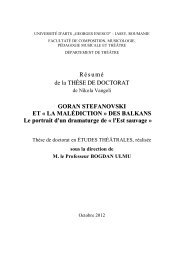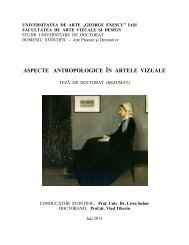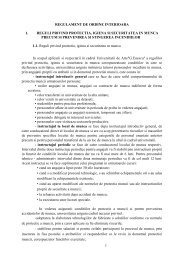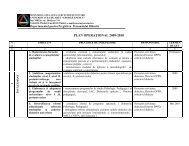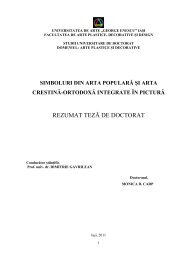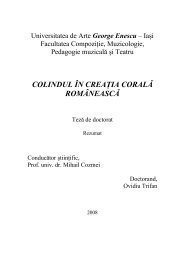vector 2_1.cdr - Universitatea de Arte "George Enescu"
vector 2_1.cdr - Universitatea de Arte "George Enescu"
vector 2_1.cdr - Universitatea de Arte "George Enescu"
Create successful ePaper yourself
Turn your PDF publications into a flip-book with our unique Google optimized e-Paper software.
176<br />
[10] G. W. F. Hegel, Introduction to<br />
the Berlin Aesthetic Lectures of the<br />
1820's, Oxford University Press,<br />
1979, i.2.2.-i.3.2, pp.14-18.<br />
[11] ibi<strong>de</strong>m, pp.20-21.<br />
[12] G. W. F. Hegel, Fenomenologia<br />
spiritului (Phenomenology of Spirit),<br />
transl. by Virgil Bogdan, IRI<br />
Publishing, Bucharest, 1995.<br />
[13] see Peter Bürger, Theory of the<br />
Avant-Gar<strong>de</strong>, Manchester University<br />
Press, 1984.<br />
[14] Though the reactive use of<br />
aesthetics against the spectacular<br />
social aestheticism is paramount in<br />
the Situationist International<br />
program of social criticism, Popart's<br />
critique of consumption,<br />
exemplary in Warhol, is still a<br />
landmark for this topic.<br />
theory about what art is and the speculative, abstract, aca<strong>de</strong>mic theory<br />
that <strong>de</strong>als exclusively with the concept (wheat we mean by art) and that risks to<br />
replace its specific object with a certain, i<strong>de</strong>al, object, a purely discursive critical<br />
10<br />
construct . How <strong>de</strong>scriptive can thus theory as theory be? How free of<br />
theoretical prejudices about what art means can be the explanation of a local<br />
artistic phenomenon?<br />
Hegel's answer is no less paradoxical, his solution being to affirm the<br />
historicity of the concept of art, whose concretisation knows specific periods of<br />
concept manifestation, while at the same time linking this empirical historicity<br />
11<br />
to the spirit manifestation forms . This second paradox, sketched out a few<br />
pages later in the introduction of the aesthetic necessity of art as freedom of the<br />
spirit, which is limited in the concrete forms of particular works, answers the<br />
paradox of the "unhappy consciousness" from the no less famous paragraph on<br />
12<br />
the dialectics of the two consciousnesses in Phenomenology of Spirit .<br />
According to the Hegelian analysis, the mutual recognition of the master and<br />
the slave remain in mutual <strong>de</strong>pen<strong>de</strong>nce, the slave's self-consciousness of<br />
<strong>de</strong>pen<strong>de</strong>nce being, <strong>de</strong>spite the restraining necessity, freer than that of the<br />
master, who needs a slave in or<strong>de</strong>r to have his existence recognised. The master<br />
is incompletely <strong>de</strong>fined just as the negative of the other, being limited by his<br />
<strong>de</strong>pen<strong>de</strong>nce on the slave, while the limited one is in fact free, in spite of the <strong>de</strong><br />
facto necessity. In the terms of Hegelian aesthetics conceived as general theory<br />
of art, art criticism is thus freer at the level of self-consciousness (as long as the<br />
<strong>de</strong>gree of freedom is <strong>de</strong>pen<strong>de</strong>nt here on the <strong>de</strong>gree of self-un<strong>de</strong>rstanding) than<br />
theory un<strong>de</strong>rstood as a generalisation on the artistic phenomenon; for its<br />
normative <strong>de</strong>finition is subject to the continually evolving artistic practice, while<br />
theory needs the criticism of particular works of art in or<strong>de</strong>r for its validity to be<br />
recognized. Proposing a philosophical questioning of its own essence, artistic<br />
practice after Warhol frees itself from its representational task, fulfilling the<br />
Hegelian prophecy of a philosophical “overcoming” of art: art becomes its own<br />
critical philosophy, simultaneously turning the normative claims of aesthetics<br />
into art criticism.<br />
Avant-gar<strong>de</strong> and artistic autonomy: the (auto)critical use of<br />
aesthetic theory<br />
The issue of art's autonomy in relation to the social and political sphere,<br />
13<br />
a correspon<strong>de</strong>nt of the invention of the mo<strong>de</strong>rn concept of art , is the one that<br />
adopts and <strong>de</strong>velops these paradoxes of the irreconcilable externality between<br />
th<br />
art and theory into the mid-20 century. In its still active horizon is<br />
encompassed the mutation of the discourse on the limits of art, from a project of<br />
their i<strong>de</strong>al objectivisation into one of archaeologisation of the relations between<br />
art and the social sphere, with the purpose, in the latter case, of exhausting the<br />
aesthetic paradigm and the instances of its criticism in artistic practice. The<br />
echo of this requirement for art autonomy, manifested by the aesthetic<br />
discourse of mo<strong>de</strong>rnity, is represented precisely by the dialectic conception of<br />
the relation between the artistic object, autarchically<br />
addressing public<br />
consciousness in terms of its own language , and its critical theory, as<br />
explicitation of this immediate and ineffable language. With the self-reflexivity<br />
gained by the artistic process in the 60's, aesthetic theory doesn't translate<br />
artistic language into philosophical speech any longer, but it rather follows its<br />
own use by the artistic act in the attempt to criticise by aesthetic means the<br />
14<br />
generalized social aestheticism .<br />
An explicit case is that of art criticism which has often theorised on<br />
specific currents, or of that particular art history discourse that has used<br />
aesthetic theory as a mo<strong>de</strong>l for explaining the marked discontinuities in mo<strong>de</strong>rn<br />
artistic practice, going as far as to suspect its own archiving project, together<br />
with the <strong>de</strong>-legitimisation of any evolution criterion that would support an<br />
intrinsic change of the concept of art. According to this interpretative practice,<br />
which assumes, in addition, the issues of justifying the avant-gar<strong>de</strong>s and the<br />
criticism they contain, the dominant theory of mo<strong>de</strong>rnity the aesthetic one has<br />
become the negative of artistic practice, its specific object of <strong>de</strong>limitation. Critical<br />
explanations have often borrowed heavily from this notion, observing in every<br />
change of the artistic practice the negative avatar of the aesthetic <strong>de</strong>finition of<br />
art, from the end of the subject to the end of the artistic object, going through the<br />
rhetoric of the end of the institutions of mo<strong>de</strong>rnity.<br />
In the first case, is well-known the explanation of minimal art in terms of<br />
"theatricality", provi<strong>de</strong>d by Michael Fried, which implies the shift on the<br />
conception of the artwork's audience. From the immateriality and, implicitly,<br />
from the (imaginary) self-absence of the contemplative subject presupposed by<br />
mo<strong>de</strong>rnist painting or sculpture, conceived in terms of the self-reflexive<br />
consciousness, audience shifts to the concrete spectator (therefore present in<br />
the act of reception), inserted into the space in which are thus asserted<br />
simultaneously the materiality of the object as irreducibility to an abstract and<br />
15 16<br />
i<strong>de</strong>al scheme . As disputed as it might be (for example by Rosalind Krauss) ,<br />
Fried's reading scheme has been accepted as a gui<strong>de</strong>line for the interpretation of<br />
th<br />
the historicity of 20 century art. Its contestation by Krauss, on the grounds of<br />
the Lacanian <strong>de</strong>-realisation of the subject-onlooker in minimal art as an<br />
exponent of the post-structuralist conception on language, itself seen as a<br />
system of differences and as a manifestation of the profound irrationality of the<br />
representational system, keeps in its turn to the framework of the same<br />
fundamental assumption of the <strong>de</strong>construction of the mo<strong>de</strong>rn subject. Its<br />
17<br />
curatorial adoption, refined by Thierry <strong>de</strong> Duve in the intention of questioning<br />
the place of the spectator-audience in the forms of the ambient or of the<br />
installation, in relation to the place of the look in mo<strong>de</strong>rnity, uses as analysis<br />
object the same assumption of autonomy of the artistic object from the social<br />
framework of its occurrence.<br />
The rhetoric of the <strong>de</strong>construction of the subject-receptor of the work of<br />
art as a monadic individual - monadic subject- also accompanies the reading of<br />
the works of late mo<strong>de</strong>rnity at the level of significant objects: both the loss of<br />
aura, proclaimed by Walter Benjamin, with the advent of technical<br />
18<br />
reproducibility , as well as the reactivity to the consumerist character of the<br />
19<br />
capitalist society, in the reading Benjamin Buchloh recently offered for the<br />
artistic neo-avant-gar<strong>de</strong>s, indicating the shift of the Adornian principle of the<br />
social negativity of artwork into a parodic assumption of the conditions of<br />
production and reception massification, presuppose the interpretation of the<br />
artistic phenomenon as a sign of cultural practice and its explanation in terms of<br />
the dissolution of artistic values by means of consumption values.<br />
The explanation of the rationale behind the birth of artistic practices<br />
discourses in terms of the change in the attributes of the aesthetic autonomy of<br />
the work of art which these discourse generate or which they assume and to<br />
which they respond, leads to a criticism of mo<strong>de</strong>rn institutions in relation to the<br />
aesthetic autonomy of the practices of reproducibility. The genealogy of the<br />
20<br />
museum, performed by Douglas Crimp , as an institution of mo<strong>de</strong>rnity that<br />
manages, according to an aesthetic theory of the work of art, its reception, treats<br />
[15] Michael Fried, «Art et<br />
Objectité», in Charles Harrison,<br />
Paul Wood, L'art en théorie 1900-<br />
1990, Editions Hazan, 1997, pp.<br />
896-910.<br />
[16] Hal Foster, Discussions in<br />
Contemporary Culture, Bay Press,<br />
Seattle, 1987, pp. 55-65.<br />
[17] Thierry <strong>de</strong> Duve, Look, 100<br />
Years of Contemporary Art, Ludion,<br />
2001.<br />
[18] Walter Benjamin, „The Work<br />
of Art in the Age of Mechanical<br />
Reproduction”, in Iluminări, transl.<br />
by Catrinel Pleşu, I<strong>de</strong>a Design &<br />
Print, Cluj, 2003.<br />
[19] Benjamin H. D. Buchloh, Neo-<br />
Avantgar<strong>de</strong> and Culture Industry,<br />
The MIT Press, 2000.<br />
[20] Douglas Crimp, On the<br />
Museum's Ruins, The MIT Press,<br />
2004.<br />
177


